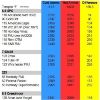It is commonly stated that ammunition performance can vary with temperature. Some powders are even sold under the claim that they are more stable. I wanted to see for myself with some of the common rounds that I shoot (factory and hand loaded).
Here's what I did:
First, thanks to Blue Bell's recall, there is room in my freezer so I loaded 5 rounds into 15 numbered magazines and left them in the freezer overnight. I then placed them in a box with a block of dry ice on top, and put that in a cooler to head to the range. I took a measurement with a digital probe inside of one of the magazines and got a reading that settled at -11.5*F. These magazines were removed one at a time and fired rapidly over a chronograph to avoid thawing the ammunition.
A frosty magazine after firing a string.

At the conclusion of each string, I reloaded the magazines with another 5 rounds. My intentions were to place the magazines in the sun to warm but some clouds moved in as I headed to the range. Instead I placed them under the hood of my vehicle and let the warm embrace of a 4.0 Jeep I6 bring them up to temperature. By the time I finished the cold ammo, I had a pile of mags under my hood. ***I do not recommend this. Ammo should be kept out of direct sun and off of engines!*** I then ran these strings over the chronograph.
Engine bay mag warmer. I took a couple readings and came up with 146.8*. Did I mention not to do this? Well, don't!

A good day at the range in my book. Seriously, you can even see my notebook in the picture.

So here it is. Enjoy.

I do want to revisit this test with a focus on AA2200 powder in the 6.8. These FMJ bullets have terrible consistency and the load represented was range fodder. My loads with Hornady HPBT and Nosler CC bullets are ~150 fps faster. I want to see if the higher pressure increases, decreases, or has no affect on the variation.
Cold brass

Here's what I did:
First, thanks to Blue Bell's recall, there is room in my freezer so I loaded 5 rounds into 15 numbered magazines and left them in the freezer overnight. I then placed them in a box with a block of dry ice on top, and put that in a cooler to head to the range. I took a measurement with a digital probe inside of one of the magazines and got a reading that settled at -11.5*F. These magazines were removed one at a time and fired rapidly over a chronograph to avoid thawing the ammunition.
A frosty magazine after firing a string.

At the conclusion of each string, I reloaded the magazines with another 5 rounds. My intentions were to place the magazines in the sun to warm but some clouds moved in as I headed to the range. Instead I placed them under the hood of my vehicle and let the warm embrace of a 4.0 Jeep I6 bring them up to temperature. By the time I finished the cold ammo, I had a pile of mags under my hood. ***I do not recommend this. Ammo should be kept out of direct sun and off of engines!*** I then ran these strings over the chronograph.
Engine bay mag warmer. I took a couple readings and came up with 146.8*. Did I mention not to do this? Well, don't!

A good day at the range in my book. Seriously, you can even see my notebook in the picture.

So here it is. Enjoy.

I do want to revisit this test with a focus on AA2200 powder in the 6.8. These FMJ bullets have terrible consistency and the load represented was range fodder. My loads with Hornady HPBT and Nosler CC bullets are ~150 fps faster. I want to see if the higher pressure increases, decreases, or has no affect on the variation.
Cold brass

Last edited:

